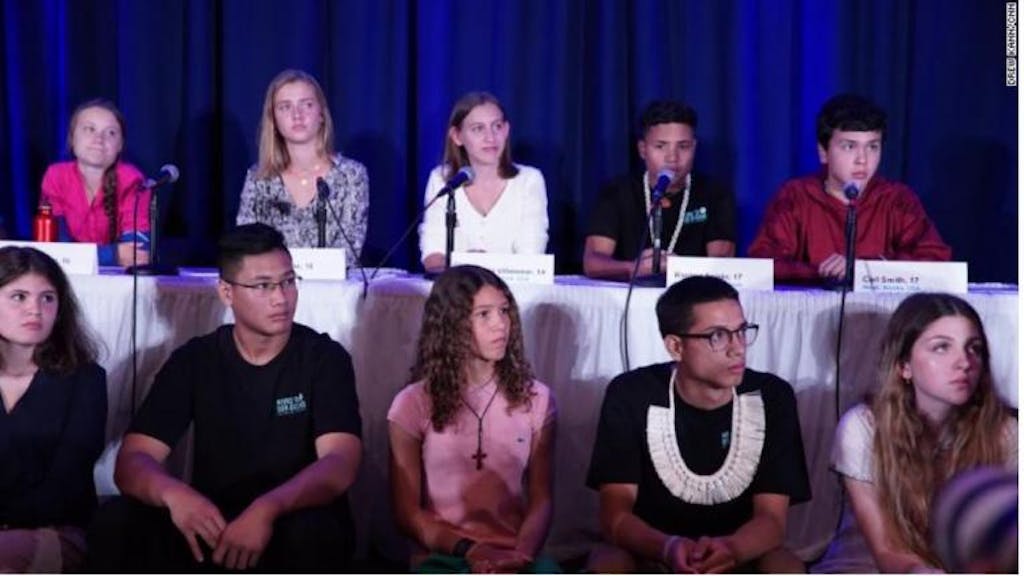Editor’s note: This post was updated December 1st, 2019.
As the world celebrates the 30th anniversary of the United Nations Convention on the Rights of the Child (CRC), 16-year-old climate activist Greta Thunberg and 15 other children are taking the treaty to the fight against climate change.
At the launch of the 74th Session of the UN General Assembly, these 16 young people – hailing from 12 different countries — filed a landmark legal complaint against five countries under the CRC. With the lawsuit receiving widespread interest from activists and media outlets alike, here are five key questions about the lawsuit to understand its potential impact on human rights and climate action.

1. What’s the lawsuit all about?
Announced at UNICEF shortly after Thunberg’s impassioned speech at the UN Climate Action Summit, the complaint claims that countries have not done enough to prevent “the deadly and foreseeable consequences” of the current climate crisis. Thunberg and the 15 other children accuse the countries of “inadequate” national pledges to curb the climate crisis because their actions will not stop the global temperature from rising less than 2°C, as agreed to within the Paris Climate Agreement. Without this vital action, they argue that the climate crisis will endanger their livelihoods — from more dangerous storms, food crises, rising sea levels, and more.
The children also call out the countries for not working hard enough to end the crisis, alleging that, “each respondent has failed to use all available legal, diplomatic, and economic means to protect children from the life-threatening carbon pollution of the major emitters.” In the lawsuit, the children call on governments to raise their climate goals and cooperate with other nations to end the crisis.
As 16-year-old Iris Duquesne of France put it, “We expect the world leaders to hear us, finally.”
2. Which countries are they calling out?
The complaint calls out Germany, France, Brazil, Argentina, and Turkey for failing to uphold their obligations under the CRC. These countries are being singled out because they are five of the world’s largest contributors to greenhouse gases, which are a direct cause of the climate crisis.
The U.S. and China are notably absent from the complaint. Why? Despite their status as the two biggest emitters of greenhouse gases, they have not ratified the CRC section that would allow complaints on potential violations of the treaty to be sent.
3. How are they filing the lawsuit?
The lawsuit is being filed under The Convention on the Rights of the Child, which was ratified 30 years ago in 1989 and is the most widely ratified treaty in history. 196 countries are party to the CRC, including every member of the UN except for the U.S.
The CRC ensures the inalienable rights of children around the world including the right to life, health, and peace. The third optional protocol of the CRC entered into force in 2014 and allows children to directly file legal complaints to the UN Committee on the Rights of the Child; however, only 44 countries have ratified this protocol. This new climate case is the first of its kind to be filed on behalf of a group of children to protect the rights of children around the globe.
4. What happens next?
In response to the complaint, the Committee, made up of 18 human rights experts from around the world, now must investigate before making recommendations. After receiving information and responses from both sides, the Committee presents their final views on the complaint and makes recommendations to all parties. They are also able to follow up on the complaint and monitor the measures that governments have taken in response to their recommendations.
Although there is no way for the Committee to strictly enforce its recommendations, the states that are party to the CRC have agreed to comply with the obligations of the Convention, and therefore have committed themselves to follow its recommendations.
On November 30, one of the petitioners, U.S.-based climate activist Alexandria Villaseñor, reported that the Committee found the case admissible. Now, the five countries singled-out will have six months to officially respond to the merits of the complaint — whether or not they see this as a human rights violation.
5. What is the likely outcome?
So far, the Committee has taken an average of two years to process a complaint and make its recommendations, and there are currently 75 pending cases. In addition to the long processing times, complaints regarding climate are also new territory for the Committee, which usually discusses cases on child migrants. Since the complaint centers on how countries will carry through on their agreed-upon climate commitments, the Committee’s recommendations will likely reinforce the countries’ obligations under the Paris Agreement.
Beyond the legal impact of this case, the complaint serves as testament to the ever-growing role of youth in activism and advocacy. These children are realizing the power of their voices and taking them to the global stage. And their voices may also encourage other young human rights defenders to do the same.



 View All Blog Posts
View All Blog Posts


